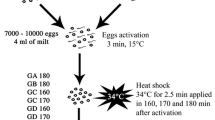Summary
The parthenogenetic elicitation of mature, fertile asci and ascospores inNannizzia incurvata,Stockd. (Sabouraudia,1: 46, 1961) and inMicrosporon gypseum,Guiart &Grigoraki, 1928 by mating them withChrysosporium species is described. The same effect was obtained when culture filtrate ofChrysosporium species alone was used instead of the living fungus. In ascospore-derivatives (ascoagarblock) profound morphological changes were observed as to the shape and size of the macro- and microconidia. The peridial ornaments showed alone or in mixture those ofNannizzia fulva, Nannizzia gypsea along with the ornaments ofNannizzia incurvata. The derivatives of parthenogenetic ascospores were different from the mother-species macro- and microscopically and remained such through many generations as stable mutants.
Zusammenfassung
Die parthenogenetische Auslösung von fruchtbaren Asci und Askosporen inNannizzia incurvata Stockd. (Sabouraudia,1: 46, 1961) und inMicrosporon gypseum,Guiart &Grigoraki, 1928 durch Kreuzung mit Arten vonChrysosporium wird beschrieben. Dasselbe Ergebnis wurde erzielt, wenn — anstatt des lebenden Pilzes — das Kulturfiltrat benützt wurde. In den Abkömmlingen der parthenogenetisch erhaltenen Askosporen (Asko-Agarblock) wurden tief gehende, morphologische Veränderungen betreffs Gestalt und Grösze der Makro- und Mikrokonidien beobachtet. Die peridialen Ornamente zeigten eine Mischung derjenigen vonNannizzia fulva, undNannizzia gypsea mit denen vonNannizzia incurvata. Die Abkömmlinge der parthenogenetisch erhaltenen Askosporen waren makro- und mikroskopisch verschieden von den originalen Stämmen und sie verblieben so durch viele Generationen als stabile Mutanten.
Résumé
La production parthénogénétique des asques et des ascospores fertiles enNannizzia incurvata Stockd. (Sabouraudia,1: 46, 1961) et enMicrosporon gypseum,Guiart &Grigoraki, 1928 par croisement avec des espèces deChrysosporium est décrite. On a obtenu le même résultat avec des filtrations des cultures liquides deChrysosporium, sans la présence du champignon vivant. Les dérivés des ascospores parthénogénétiques présentent un changement morphologique profond quant'à la forme et à la grandeur des macro- et microconidies. Des ornements peridiales présentent une combinaison de ceux deNannizzia fulva, Nannizia gypsea et deNannizzia incurvata. Les dérivés des ascospores parthénogénétiques sont différents en leur forme macro- et microscopique de l'espècemère, et sont restés sans change par de nombreuses générations comme une mutation stabile.
Similar content being viewed by others
References
Benedek, T., 1961. Elicitation of perfect organ of fructification in Sabouraud's form-genusMicrosporon (pro parte) by means of symbiosis withB. weidmaniensis,Benedek, 1938. Mycopath. & Mycol. appl.14: 101–122.
Benedek, T., 1964. A new dermatophyte,Thallomicrosporon kuehnii Benedek, 1963. Mycopath. & Mycol. appl.23: 85–98.
Benedek, T., 1967. On the ancestral form of true organ of fructification in the saprophytic stage of the dermatophytes of the Faviform group:Favomicrosporon pinettii. n. sp. and its perfect form:Anixiopsis stercoraria (Hansen)Hansen, 1897. Mycopath. & Mycol. appl.31: 81–143.
Bessey, E. A., 1939. Textbook of Mycology, Corrected reprint. P. Blackiston's Sons & Co. Philadelphia. p. 6/7.
Dade, H. A., 1960. in Herb. I.M.I. Handbook, Commonwealth Mycological Institute, pp. 40.
Flórián, E., Galgóczy, J. &Novák, E. K., 1964. AreMicrosporon distortum di Menna &Marples, 1954 andMicrosporon umbonatum Sabouraud, 1907 identical? Mycopath. & Mycol. appl.23: 39–44.
Flórián, E. &Galgóczy, J., 1964.Keratinomyces longifusus, sp. nov. from Hungary. Mycopath. & Mycol. appl.24: 74–80.
Padhye, A. A. &Carmichael, J. W., 1968. Mating reactions ofTrichophyton simii andT. mentagrophytes strains from poultry farm soil in India. Sabouraudia6 (3): 238–240.
Peacock, A. D., 1961. In the Encyclopedia of the Biological Sciences, edited byP. Gary. Reinhold Publ. Corp. New York.
Stockdale, Phyllis M., 1968. Sexual stimulation betweenArthroderma simii Stockd., Mackenzie &Austwick and related species. Sabouraudia,6 (2): 176–181.
Author information
Authors and Affiliations
Rights and permissions
About this article
Cite this article
Benedek, T. Parthenogenetic production of fertile Cleistothecia in Nannizzia incurvata stockd. Under the influence of Chrysosporium species. Mycopathologia et Mycologia Applicata 37, 193–214 (1969). https://doi.org/10.1007/BF02051354
Issue Date:
DOI: https://doi.org/10.1007/BF02051354




